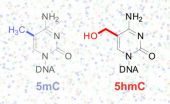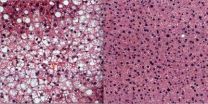Led by researchers from the Wellcome Trust Sanger Institute, the team created a catalogue of all the mutations in the genomes of the 21 cancer genomes and identified the mutational processes that lead to breast cancer. They found that these mutations accumulate in breast cells over many years, initially rather slowly, but picking up more and more momentum as the genetic damage builds up.
By the time the breast cancers are large enough to be diagnosed, they are made up of a number of genetically related families of cells, with one such family always dominating the cancer.
All cancers are caused by mutations, called somatic mutations, acquired throughout a person's lifetime in the DNA of initially normal cells. Little is known about the processes that underlie the development of many somatic mutation patters. These studies delve more deeply into the evolution of breast cancers, discovering a number of new mutation processes that can cause many thousands of mutations in a tumour, and drive its development.
Nearly 290,000 people are diagnosed with breast cancer each year in the USA, and approximately 40,000 die. Breast cancer is the most common cause of all deaths in women aged over 40 and is the second biggest cause of death from cancer for women in the USA, after skin cancer.
"To be able to deal with breast cancer in the most effective way, we need to understand fully the processes that cause it," explains Dr Peter Campbell, Head of Cancer Genetics and Genomics from the Wellcome Trust Sanger Institute. "Whole genome sequencing from cancers is not a new concept, but this is the first time that we've been able to delve fully into breast cancer genomes in such a thorough way. This has given us a full panoramic view of the cancer genome and has allowed us to identify mutational patterns rather than individual mutations in specific genes."
To determine the processes that underlie breast cancer, the team catalogued all the mutations that had arisen in the 21 breast cancers. One of the processes they found was characterized by pockets of massively mutated regions in the genome. This sudden 'downpour' of mutations is frequently seen in breast cancers. The team called this phenomenon, which has never been seen before, kataegis after the Greek for thunderstorm.
The team found that different mutational processes act at different times in the lifespan of a breast tumour. Some mutational processes act throughout the evolution of the cancer and some processes only emerge late on in the development of the cancer. One particular mutational signature was indicative of a form of inherited breast cancer, and is linked to an inability to correctly repair breaks in DNA.
"These findings have implications for our understanding of how breast cancers develop over the decades before diagnosis in adults and might help to find possible targets for improved diagnosis or therapeutic intervention in the future," says Professor Mike Stratton, author and Director of the Wellcome Trust Sanger Institute. "Harnessing the power of whole genome sequencing, we were able to access the entire genome rather than focusing on mutations in specific regions."
Similar analyses will be undertaken in 1000s of cancer genomes, under the full programme of the International Cancer Genome Consortium, and the team expect many more mutational processes will be defined along the way.
"We are used to thinking about Darwinian evolution of species by natural selection taking place over centuries and millennia. But in cancer and infectious disease similar processes can be observed over much shorter periods," says Sir Mark Walport, Director of the Wellcome Trust. "These studies, which follow from the human genome project, are untangling the evolutionary processes that eventually lead to breast cancer, in a way that would have been impossible only a few years ago.
"We are starting to see the landscape of mutation that characterises this disease in something approaching its full complexity for the first time. As this work continues, we can hope to understand how breast cancer develops and thus how it might be treated more effectively."
Mutational processes behind 21 breast cancers:
The team found almost 200,000 mutations in the genomes of the 21 breast cancers. By examining the mutations from each cancer, they could discern different patterns of mutation, which appear to represent traces of past mutational mechanisms that have acted on the genomes of individual cells during the life of the patient. These traces are like archaeological imprints left in the DNA of the cancer cell by mutational processes which could have been active many years before the cancer came to attention. Previously, there was little, if any, knowledge about most of these processes and the 21 breast cancer samples seem to have been assaulted by different combinations of them.
"What emerges is a really complex landscape of mutation, where each cancer seems to have been generated by a different combination of mutation processes," says Professor Mike Stratton.
"In our analyses, we have excavated these cancer genomes, in a similar manner to an archaeological dig, and uncovered patterns of mutation that had never been seen before. We do not know for sure what the underlying biological mechanisms causing these mutation patterns are. However, we suspect certain processes in normal cells that generate mutations have been overactive and simply caused too many mutations, hence leading to cancer.
"We do not think that these mutation patterns are due to external exposures like tobacco smoke or sunlight, which are known to cause mutations and cancer, but more likely are due to defective internal cellular machinery. However, further work needs to be conducted to confirm this view."
One of the novel mutation mechanisms is a remarkable process that leads to large numbers of mutations in small regions of the genome. The authors call this "kataegis‟ (from the Greek for thunderstorm): although never described before, kataegis was remarkably common occurring, to some extent, in the genomes of 13 of the 21 breast cancers. The dense bursts of mutations in each patch of kataegis are likely to have occurred at one point in time rather than accumulated in a step-wise fashion over the lifetime of the cancer.
"In kataegis, a large number substitution mutations occur very close together in the genome," says Dr Serena Nik-Zainal, first author from the Wellcome Trust Sanger Institute. "They show a distinguishing mutational motif and frequently co-occur with large-scale rearrangements: it is a unique mutational pattern.
"We expect that this phenomenon is not restricted to breast cancer and might operate in other cancers. Current sequencing technologies allow us to make these discoveries which were hidden from us before. "
The pattern of mutations in kataegis is highly distinctive, and the team speculate that there is a relationship between kataegis and a protein family, APOBEC. Members of this family can induce similar mutational changes in experimental systems and are thought to play a role in defence against viruses.
The mutational processes identified by the researchers allowed them to distinguish cancers from women with known BRCA1 and BRCA2 mutations from other, more common or sporadic, breast cancers. The team speculate that these distinguishing mutational patterns might be present in other types of cancer and could help to predict response to treatments such as PARP inhibitors to which BRCA1/BRCA2 cancers are particularly sensitive.
Life history of 21 breast cancers:
"We wanted to see if we could decipher this history encrypted in the genome of each of the cancers," explains Dr Peter Campbell. "All cancers are made up of a collection of families of cells. Whole genome sequences reveal the genetic record of their emergence over time and allow us to trace the divergence of a cell to form the different families."
As cells divide and multiply, mutations accumulate naturally: the team found that, as these mutations accumulate in a cell, the changes drive divergence of the cancer into different subgroups or clones. The scientists showed that emergence of different clones was universal in the breast cancers they examined.
They also showed that one sub-clone becomes the dominant population of cancer cells. This dominant sub-clone accounts for more than 50 per cent of tumour cells in all of the breast cancers analysed, and it is only when this sub-clone has grown sufficiently populous that the tumour becomes clinically detectable. It differs from the other clones present in a tumour by many hundreds to thousands of mutations, indicating that this final stage in a cancer's emergence may take quite some time.
"We undertook a deep excavation of the tumour DNA," says Dr Serena Nik-Zainal, "revealing for the first time the fine structure of breast cancer genomes. We took all this data and integrated it to build an evolutionary tree of the cancers.
"This method allowed us to determine when divergence occurs, what processes are involved in the different stages of cancer evolution and the proportion of each sub-clone present in the tumours."
The team found that some mutational processes act throughout the evolution of the cancer and some processes are present only quite late in the development of the cancer once divergence has occurred.
For example, four of the cancers had many extra copies of the gene that is the target of the Herceptin drug. The team found that the first few extra copies of the gene were gained very early in the development of the breast cancer, but it took the cancer a much longer period of time than expected to accumulate all of the extra 20-30 copies.
"Current cancer treatments do not take sub-clonal diversity into account and often target only the dominant sub-clone," explains Professor Mike Stratton. "This leaves the possibility that one of the minor sub-clones will then replicate and become dominant, leading to re-occurrence of the tumour.
"Understanding sub-clonal diversity in breast cancer is a pivotal part of treating this destructive cancer in the most efficient way. This study forms the basis to identify sub-clones both minor and dominant."
These findings have significant implications for our understanding of how breast cancers develop over the decades prior to diagnosis. The next step for this research is to sequence more genomes and cancer types, and also to refine current methods.
###
Publication Details
Nik-Zainal et al „The Life History of 21 Breast Cancers‟
Published in Cell on 25 May 2012. DOI: 10.1016/j.cell.2012.04.023
Nik-Zainal et al „Mutational Processes Molding the Genomes of 21 Breast Cancers‟
Published in Cell on 25 May 2012. DOI: 10.1016/j.cell.2012.04.024
Funding
A full list of funding agencies can be found in the papers
Participating Centres
A full list of participating centres can be found in the papers.
Selected Websites
The Wellcome Trust Sanger Institute is one of the world's leading genome centres. Through its ability to conduct research at scale, it is able to engage in bold and long-term exploratory projects that are designed to influence and empower medical science globally. Institute research findings, generated through its own research programmes and through its leading role in international consortia, are being used to develop new diagnostics and treatments for human disease. http://www.sanger.ac.uk
The Wellcome Trust is a global charitable foundation dedicated to achieving extraordinary improvements in human and animal health. We support the brightest minds in biomedical research and the medical humanities. Our breadth of support includes public engagement, education and the application of research to improve health. We are independent of both political and commercial interests. http://www.wellcome.ac.uk
END



